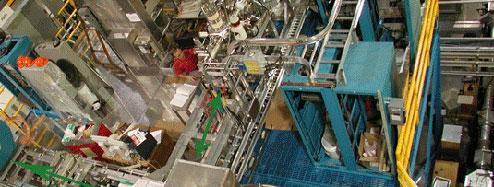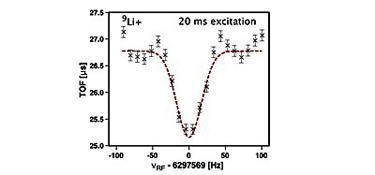
On the weekend of August 24 – 26, 2007, physicists on the TITAN experiment (S1074) took the first Penning trap mass measurements of radioactive lithium isotopes -- the lightest on-line produced ions ever trapped. The goal of the experiment was to determine the two neutron separation energy of the halo nucleus 11Li, which requires the knowledge of the ground state mass of both short-lived nuclei lithium-9 and lithium-11. In the first on-line beam time of TITAN, the masses of 6,7Li (both stable) and 8,9Li were determined with high precision (dm/m~ 10-7).
 TITAN is one of TRIUMF’s more complex experiments, in which the ions with half-lives well below a second (9Li T1/2 = 178 ms) are first trapped, cooled, and bunched in a linear RF trap. Then the lithium ions are extracted, energy adjusted, and finally delivered to the Penning trap. Here the mass is determined via the cyclotron frequency measurement of the ions in the strong magnetic field (4 Tesla) of the Penning trap. Exploring the isotopic “landscape” helps physicists build models of nuclear interactions. Precision mass measurements from TITAN will improve our understanding of the astrophysical reaction paths that create all visible matter.
TITAN is one of TRIUMF’s more complex experiments, in which the ions with half-lives well below a second (9Li T1/2 = 178 ms) are first trapped, cooled, and bunched in a linear RF trap. Then the lithium ions are extracted, energy adjusted, and finally delivered to the Penning trap. Here the mass is determined via the cyclotron frequency measurement of the ions in the strong magnetic field (4 Tesla) of the Penning trap. Exploring the isotopic “landscape” helps physicists build models of nuclear interactions. Precision mass measurements from TITAN will improve our understanding of the astrophysical reaction paths that create all visible matter.
TITAN (TRIUMF’s Ion Trap for Atomic and Nuclear science), is funded by NSERC and supported by NRC and TRIUMF. It is operated by a Canadian collaboration with group members from Germany, France, the UK, and the US and measures masses of short-lived isotopes and, via Einstein’s famous energy-mass relation e=mc2, determines the binding energy of the nucleons. The main motivations are tests of fundamental symmetries, nuclear astrophysics, and nuclear structure.
Experiment 1074 is a collaboration among Canada (University of British Columbia, University of Manitoba, University of Windsor, McGill University, and TRIUMF); the United States (Colorado School of Mines); France (Institut Physique Nucléaire d’Orsay); and Germany (Technical University of Munich).
The determination of the 11Li (8 ms half-life) mass is scheduled for the next on-line run, starting December 14, 2007.
